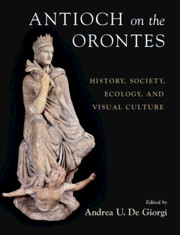Book contents
- Antioch on the Orontes
- Antioch on the Orontes
- Copyright page
- Dedication
- Contents
- Plates
- Figures
- Tables
- Contributors
- Abbreviations
- Antioch on the Orontes
- Part I Beginnings
- Part II The Making of a Capital
- Part III The People of Antioch
- Chapter 15 Women in Imperial Antioch
- Chapter 16 The Middle Classes in Fourth-Century CE Antioch
- Chapter 17 Antioch
- Chapter 18 Violence in Antioch
- Chapter 19 Antiochene Riots against Jews in Malalas’s Chronicle
- Chapter 20 Speaking of Jews
- Chapter 21 Antioch and the Political Economy of Empire in the Age of Justinian
- Part IV Religion
- Part V Crises and Resilience
- Index
- Plate Section
- References
Chapter 18 - Violence in Antioch
from Part III - The People of Antioch
Published online by Cambridge University Press: aN Invalid Date NaN
- Antioch on the Orontes
- Antioch on the Orontes
- Copyright page
- Dedication
- Contents
- Plates
- Figures
- Tables
- Contributors
- Abbreviations
- Antioch on the Orontes
- Part I Beginnings
- Part II The Making of a Capital
- Part III The People of Antioch
- Chapter 15 Women in Imperial Antioch
- Chapter 16 The Middle Classes in Fourth-Century CE Antioch
- Chapter 17 Antioch
- Chapter 18 Violence in Antioch
- Chapter 19 Antiochene Riots against Jews in Malalas’s Chronicle
- Chapter 20 Speaking of Jews
- Chapter 21 Antioch and the Political Economy of Empire in the Age of Justinian
- Part IV Religion
- Part V Crises and Resilience
- Index
- Plate Section
- References
Summary
Antioch’s circuses and theaters are well known; however, how they gradually became locus to faction rivalries and hotbeds for civic strife is brought into focus by this chapter.
- Type
- Chapter
- Information
- Antioch on the OrontesHistory, Society, Ecology, and Visual Culture, pp. 298 - 311Publisher: Cambridge University PressPrint publication year: 2024



